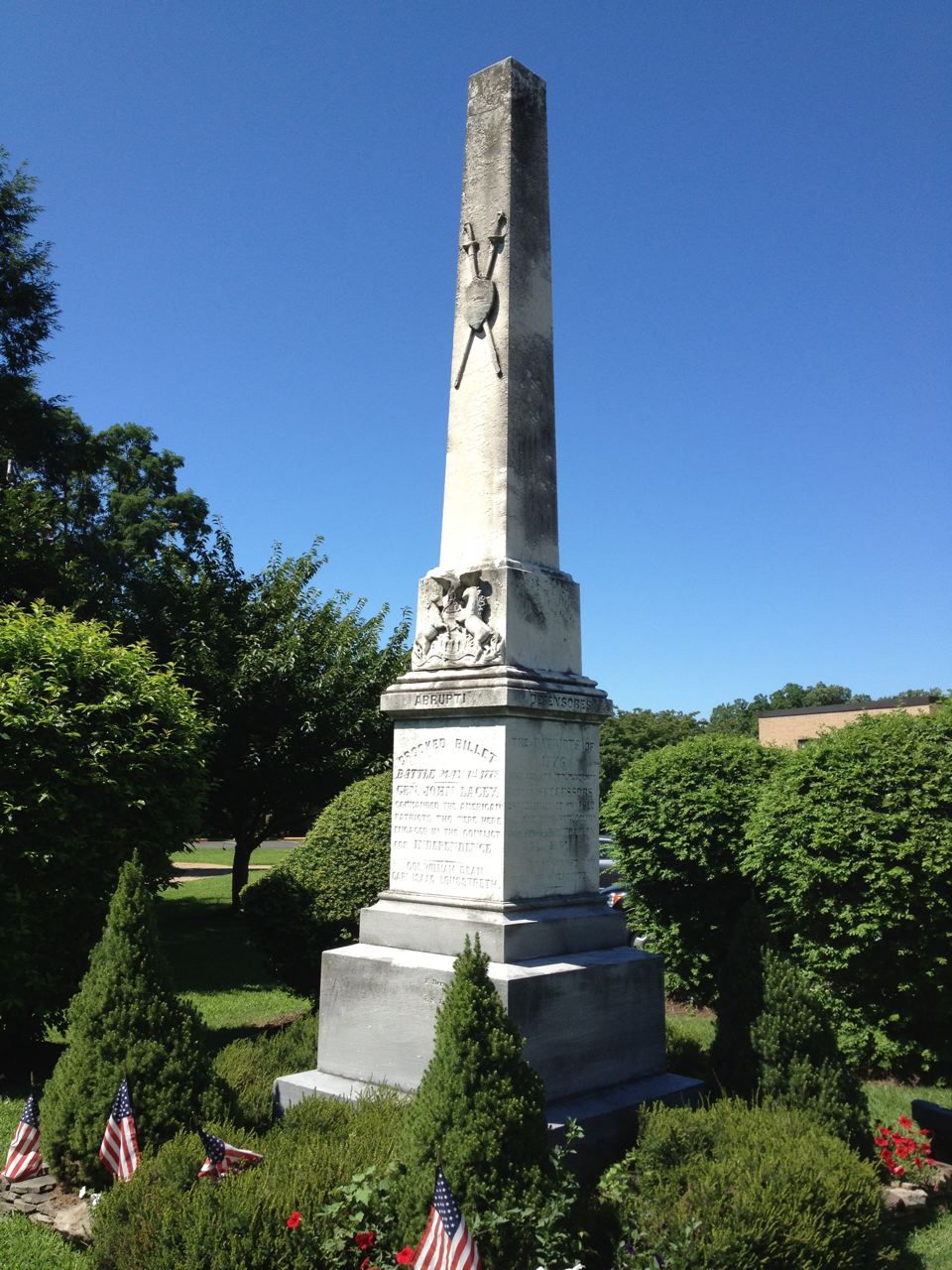
On December 5, 1861, the residents of several Philadelphia suburbs gathered at Hatboro, Pennsylvania, to dedicate a monument to the men of their community who had died during the Battle of Crooked Billet on May 1, 1778. In that surprise attack during the American Revolution, the British army had routed a local band of Pennsylvania militia and allegedly massacred and mutilated some of the two dozen Patriots they killed. Now they would remember and commemorate their community’s role in the war that brought about American independence.
The movement to build the Crooked Billet monument had been spearheaded during the spring and summer of 1860 by a group of local women, as well as the famous Philadelphia newspaperman John W. Forney, and local Doylestown editor W. W. H. Davis, who soon would become the colonel of the 104th Pennsylvania Volunteers. During the ensuing year and a half, money was raised, land acquired, a stone foundation laid, and a 24-foot Italian marble obelisk carved. But when the local citizens gathered in December 1861 to celebrate their community’s role in the War for Independence, their focus had changed from the past to the present. Now they were engaged in a great Civil War.
One man present at the dedication declared that the “olden scenes of 1776 were being enacted over again by those brave spirits who have obeyed their country’s call and are now at the seat of war.” Another proclaimed, “Let it not stand [as] a monument to our shame, to tell to coming generations that we were too weak to keep what our fathers entrusted to our hands.”
Indeed, the Civil War was on everybody’s mind when they stood around the pristine marble testament to their forebears. This “monument is a tribute to patriotism,” declared the main orator for the occasion, Rev. Jacob Belville. But it was not simply a monument to the patriotism of the Revolutionary generation. It must also be a reminder to the living to fulfill what their honored dead had begun. “The men to whom this monument is reared, were patriots,” he continued. While “it is true” that they may not have accomplished “great deeds” that would be remembered throughout the world; still, “they did the greatest deed man can do for his country, they died in its defence. They stood in their lot, between their country and her foes. They fought until they fell the victims of treachery and violence, all that the bravest and the best could do.”
Belville reminded his listeners that some 600,000 northern men had already answered their country’s call by December 1861. Many of their “names will never be known to fame,” he said, just like the now-unknown militiamen who fell at Crooked Billet. But, Belville continued, “Let your monuments ever be reared, not so much to great deeds as to brave and loyal hearts, that, in the holy atmosphere that surrounds them, your children may breathe the inspiration of true patriotism, and before them swear eternal fidelity to their country, if not eternal hatred to its foes.”
Belville believed that the Crooked Billet monument would now stand before the present generation as “a plea for the Republic” and a “plea for its perpetuity.” The nation “must not fall,” he implored his audience. As the crowd listened, Belville urged them to contemplate “the wild woods, and humble, scattered dwellings, by which this spot was surrounded in revolutionary times.” How far the nation had come in just eighty-three short years. Now the monument stood in a thriving community, surrounded by “cultivated fields, . . . cheerful homes and smiling villages.” Such a transformation in the landscape testified to “the beneficence of that government which under God has been the author of this prosperity not only here but in every portion of this mighty land.” Hatboro, Pennsylvania, in short, was one small place, like many others in the Union, that prospered because of the unity of the nation. But the progress of the past eight decades must not be abandoned or taken for granted. It now belonged to the living to continue what their ancestors had begun. “The history which it hands down reminds us that this free government was bought with blood, and fires us all with devotion to resolve,—it shall never be sold for less.”
These sentiments—connecting the defenders of the Union to their Revolutionary forefathers—were carved into the south side of the marble obelisk, thus making the monument to the Battle of Crooked Billet the first real monument to the soldiers of the Civil War:
The Patriots of 1776
ACHIEVED OUR INDEPENDENCE.
Their Successors
ESTABLISHED IT IN 1812.
We are now struggling
FOR ITS PERPETUATION IN 1861.
“The Union must and shall be Preserved.”
Jonathan W. White is an assistant professor of American Studies at Christopher Newport University and the author of Abraham Lincoln and Treason in the Civil War: The Trials of John Merryman (Louisiana State University Press, 2011) and Emancipation, the Union Army, and the Reelection of Abraham Lincoln (Louisiana State University Press, 2014). In 2015 he will publish Lincoln’s Advice to Lawyers with Sourcebooks/Cumberland House, and he is presently writing a history of sleep and dreams during the Civil War. To learn more about his research and teaching, please visit http://www.jonathanwhite.org/.
Sources: W. W. H. Davis, History of the Crooked Billet, Fought May 1st, 1778 (Doylestown, Pa.: Doylestown Democrat, 1860); several issues of the Doylestown Democrat from December 1861 and January 1862; Jacob Belville, Address at the Inauguration of the Hatborough Monument, Commemorating the Battle of the Crooked Billet, Delivered in Loller Academy, December 5, 1861 (Doylestown, Pa.: W. W. H. Davis, 1862).
Photo Courtesy of the Author.